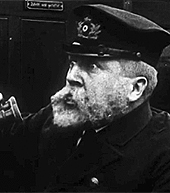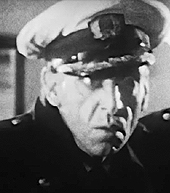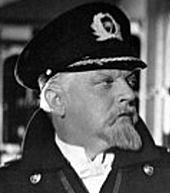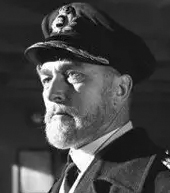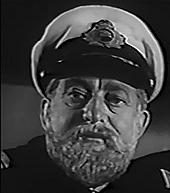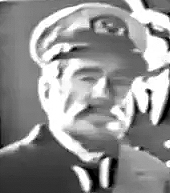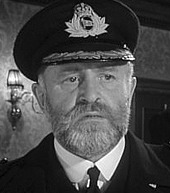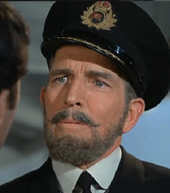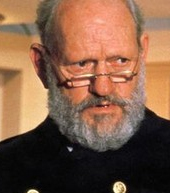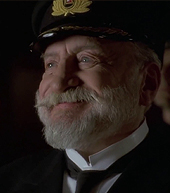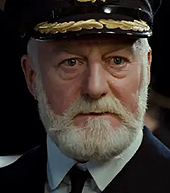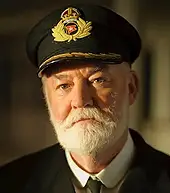Side Menu:
Captain E.J. Smith - Film Portrayals
Captain Smith's legendary status was affirmed with a series of iconic portrayals, most notably the following:
(Click on the thumbnail to go directly to each portrayal)
Otto Rippert, "In Night and Ice" (1912)
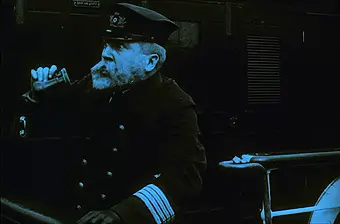
The Captain (Otto Rippert) reacting to the iceberg
(Click to enlarge)
In August 1912 – only months after the disaster – an epic 40-minute recreation of the story was produced by Continental-Kunstfilm of Berlin, by 24-year-old Romanian director Mime Misu, entitled “In Nacht und Eis” (or “In Night and Ice”). With a focus on the heroism of the crew, the captain is the main role and performed by 43-year-old Otto Rippert, sporting a clearly false, stick-on beard. This film is his only acting credit (as “Kapitän”) as he was the studio’s director. This may in some way explain his overdramatic acting that borders on comedy, especially his reaction to the iceberg which along with the First Officer would be more fitting in a Charlie Chaplin film. In a particularly dramatic sequence, after the flooded boiler room explodes, the Captain and the wireless operator decide to go down with the ship. In the final scene, the Captain rescues a man drowning in the water, but then refuses a spot in the lifeboat and sacrifices himself by returning to the ship. The closing shot is of his cap floating in the water, a poignant end to the film.
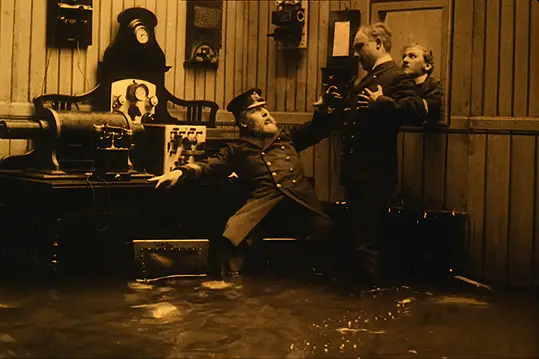
German actor Otto Rippert as the "Kaptain", in the wireless room. (Click to enlarge)
For more information on this film, the first to portray Captain Smith, check this article, including a full version of the film remastered in English and with a new score here:
In Nacht und Eis - "In Night and Ice" - 1912 German Titanic film
Gordon James, "Atlantic" (1929)
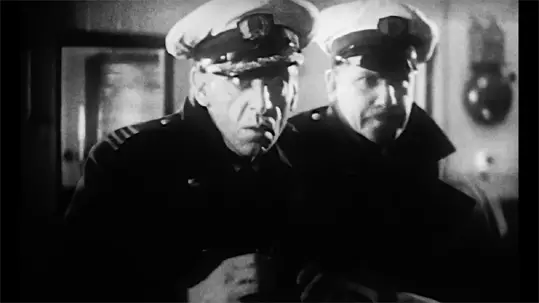
Gordon James (left) as Captain Collins, in the 1929 film "Atlantic".
In 1929, a film entitled “Atlantic,” based on the West End play “The Berg,” was released, significant as one of the first British films to feature sound (in what was then called a “talkie”). It takes place on a ship christened the Atlantic with a master named Captain Collins, played by Gordon James, but it is clearly more than just inspired by the Titanic disaster. The popular story is that the White Star Line threatened a lawsuit if they used the name Titanic; in modern parlance it was still “too soon.” The beardless Captain Collins is shown smoking a pipe in his first scene and warning “Officer Lancaster” to be careful not to “needlessly worry” the passengers – likely with talk of ice. He is on the bridge during the iceberg collision and shouts, “hard a starboard” and “engines dead slow.” He is briefly seen writing a wireless message and then towards the end using a large megaphone to call out “every man for himself.” Collins final scene has him telling an eager Lancaster that while he is no longer under his orders, he should in any case attempt to save a young girl – even if there is not room for the officer in the last lifeboat.
Otto Wernicke, "Titanic" (1943)
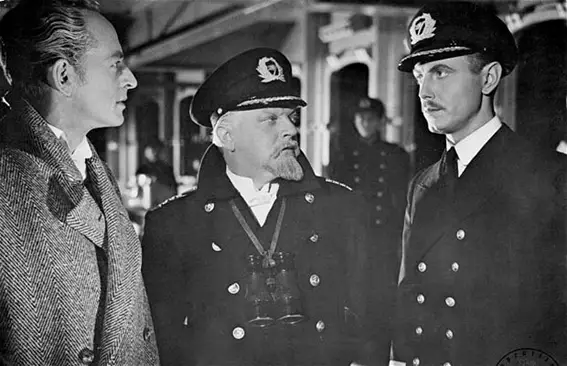
Otto Wernicke, as “Kapitän Smith” (middle) is caught between the ruthless ‘President Ismay’ (Ernst Fritz Fürbringer) and the heroic Officer ‘Petersen’ (Hans Nielsen) in the 1943 German film “Titanic.”
With the character of Collins in the 1929 film "Atlantic" bearing little resemblance at all to Smith, it would be another 31 years before another German film was created with similar ambition to its 1912 predecessor – the 1943 so-called ‘Nazi’ version simply titled “Titanic.” Ironically, with a dramatic upheaval in history during the three decades that separate these two films, the focus changed from one of heroism to an overtly political agenda and strong anti-British messaging. Commissioned by Nazi Propaganda Minister Joseph Goebbels, the intent was showing not only the superiority of German filmmaking but also that British and American capitalism was responsible for the disaster.
The role of the Captain was played by the short German actor Otto Wernicke, then aged 50, with a distinctive ‘goatee’ beard (Figure 236). Wernicke is best known for his role as police inspector Karl Lohmann in the two Fritz Lang films M and The Testament of Dr. Mabuse. Interestingly, Wernicke was married to a Jewish woman. Only due to a special permit and substantial donation to the Nazi Party was he allowed to continue his work in Nazi Germany. He appeared in the 1944–1945 propaganda epic Kolberg (Source: Wikipedia).
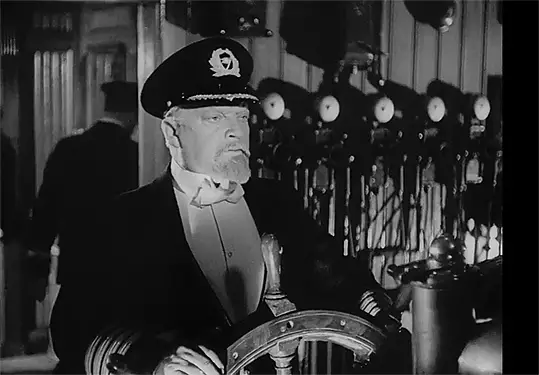
Otto Wernicke, as “Kapitän Smith”
The tone is set by the Captain’s first appearance when “President Ismay” simply offers him $5,000 to arrive on schedule in New York and another $1,000 for every hour ahead of schedule. There was no subtlety in the messaging. The next time the Captain appears, he is once again with Ismay and this time with fictional German “Officer Petersen” expressing concerns over impending ice, which Ismay overrides with a demand to “maintain direct course at full speed.” The Captain responds weakly by saying “This is a huge responsibility.” Ismay reiterates his earlier indication that he will reward Smith for speed and we next see the Captain addressing his officers in the bridge, wearing a tuxedo, screwing up an ice message (“The Baltic is a little tub” he says) and ordering “no change… full speed ahead.” He then appropriately leaves for the “ballroom.”
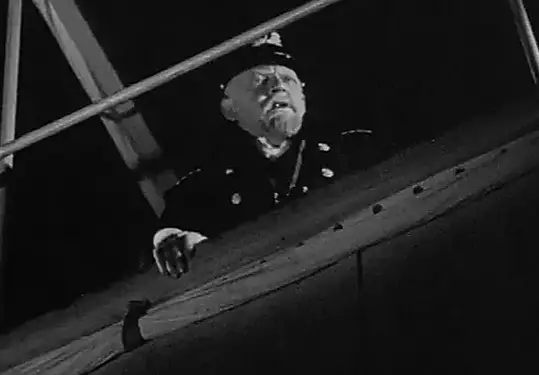
When the ship encounters the iceberg and flooding is reported in the engine room, Officer Petersen finds the Captain socialising with two glamorous women in the ballroom. Back on the bridge, the Captain initially chastises his officers for being “too pessimistic” but, on learning of the damage, orders a distress call (CQD) be made on the wireless and tells Petersen to calm the passengers by telling them the disturbance was a “manoeuvre to avoid drift ice.” Even when ordering to get the passengers on deck, the Captain tells his officers to “lie to them as long as you can” by explaining it is just a drill. Looking increasingly miserable, he is later seen ordering the orchestra to play, spotting a vessel on the horizon and angrily reprimanding Petersen for firing white distress flares instead of red, causing the nearby Californian to ignore them. Further, when Ismay offers to use his “influence” to ensure “nothing untoward” happens to Smith, the Captain replies by admitting he was wrong to have followed his orders and that he will not help save him. Once the last lifeboat has departed, Smith gathers his officers and tells them “You have done your duty” and releases them. He is last seen walking forlornly, left alone in the bridge.
Brian Aherne, "Titanic" (1953)
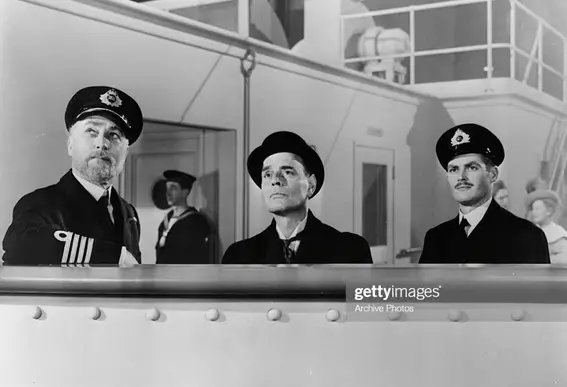
Brian Aherne (left) was an Oscar-nominated Anglo-American stage and screen actor, seen here in the 1953 Twentieth Century-Fox production of "Titanic"
Aherne first appears in the film drinking tea on the bridge while receiving instructions from White Star’s Mr Sanderson to ensure a ‘record run’ on the maiden voyage as the band plays “Royal Britannia” in the background. The drinking of tea while on bridge duty became something of a common motif used to depict British overconfidence. The Captain is also shown receiving an old flag from his days as an apprentice 40 years earlier, which he has hoisted up Titanic’s forward mast while they are docked in Cherbourg. Smith is later shown reading a note from officer Murdoch about a lack of binoculars. And while Lightoller is worried about the increase in speed, the Captain, having just taken the Sunday religious service in first class, assures him it is nothing of concern as the weather is clear and their track is south of the reported ice. He even introduces Lightoller to the Astors, explaining that that the Second Officer is “worried about our ship” and rather condescendingly says: “I like your spirit, Mr Lightoller.”
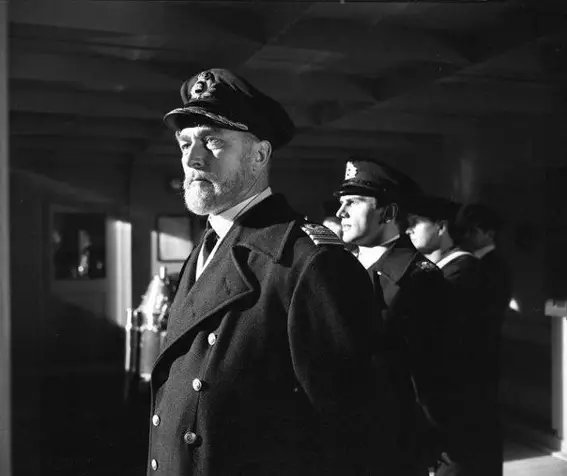
Brian Aherne as Captain Smith on the bridge. He ironically starred in another film with a familiar title, "A Night to Remember." However, it was a totally different story than the one that most Titanic aficionados are familiar with.
When further ice reports arrive, the Captain is not particularly concerned about changing course. Just prior to the iceberg collision, he sits down and watches a sing-along in first class, smoking a long pipe and softly singing along to the Cornell University alma mater song “Far Above Cayuga’s Waters.” Roused by the impact, he rushes to the bridge and on receiving reports of flooding he changes from a man of overconfidence and detachment to a man of action. He immediately orders the lowering of the lifeboats and then rushes to the Marconi room and tells the wireless operators to send a CQD distress message. When pressured by a passenger, played by Clifton Webb, to tell the truth, the Captain not only tells him the ship is sinking but indicates there are not enough lifeboats. The Captain is then briefly seen in the Marconi room learning that the Carpathia is on its way, and then in the boiler room asking if the steam can be kept up to keep the Marconi instrument going and the lights burning. He also instructs the band: “I think it might help if you play.” Finally, after ordering a last entry be made in the logbook that ‘all lifeboats manned and lowered and sinking hard by the bow’ he joins the throngs gathered on the port boat deck who are singing a choral version of “Nearer my God, to Thee.”
Notably, he does not sing. Just before the ship sinks below the waves, Captain Smith glances up at the old flag from his apprentice days still hoisted on the forward mast. Although not based on any fact, or even anecdotal evidence, it is a touching cinematic moment on which to end the film.
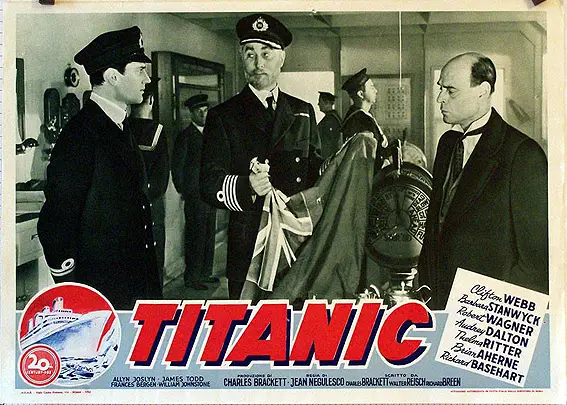
(Click image to enlarge)
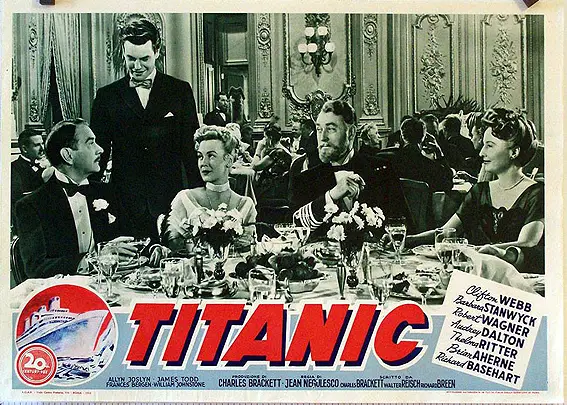
(Click image to enlarge)
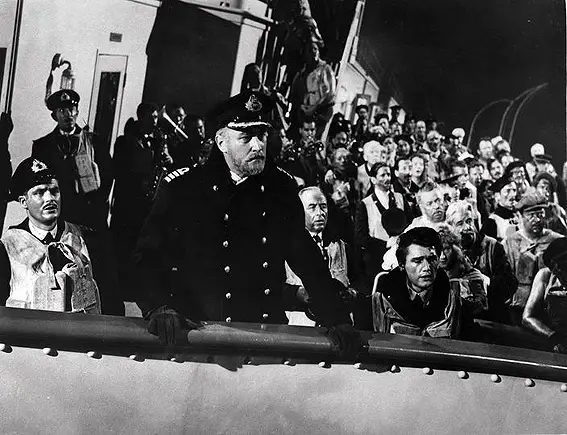
(Click image to enlarge)
Noel Drayton (1955) — "You Are There" (TV)
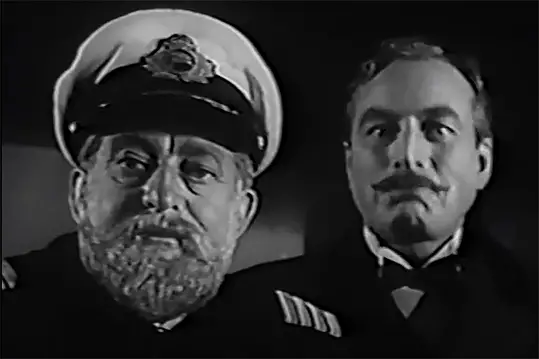
Noel Drayton as Captain Smith in the 1955 TV episode "You Are There," along with "Lord" Ismay (Lowell Gilmore).
The same year, before Lord’s book was released and during a time when television was becoming more accessible and popular, Walter Cronkite’s “You Are There” series featured an episode entitled “The Sinking of the Titanic (April 14–15, 1912).” The TV programme was shot reportage-style, with key players interviewed on camera during historical events as if it were breaking news. On the 22 May 1955, Cronkite introduced the Titanic during episode 38 of season 3, the opening scene of the half-hour show beginning with a reporter interviewing Captain Smith and "Lord" Bruce Ismay, with much emphasis on the breaking of records, and Smith’s annoyance with Ismay palpable.
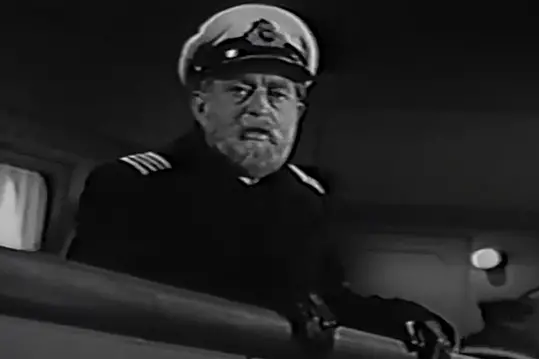
Noel Drayton as Captain Smith .
Smith was played by 41-year-old Noel Drayton, who, when asked about the danger of icebergs, responds, talking directly to camera: “We travel so much faster than they do, that of course we can get out of their way.” Officer Murdoch is midway through an interview stating they are doing 24-and-a-half knots, and there is no need so slow down, when the collision suddenly occurs. Smith is on the bridge in a flash and responds by claiming it was a “good thing we didn’t hit it head on.” Later, Smith tells first class passenger Frederick Hoyt “we are ripped from stem to stern… the gash must be some 300-foot-long.” Toward the end, Hoyt says goodbye to the Captain after realising that he will go down with the ship – an interesting reference to Hoyt’s eyewitness account of his last moments with Captain Smith, the only production to ever include it. In a slightly humorous aside, a steward complains about passengers on B deck causing damage to company property, to which the Captain responds dryly: “Your devotion to your company is admirable. I shall always remember it. And now, I suggest you do something about leaving the ship before she sinks.” The steward is shocked. “Sinks? But I am responsible to the Company, sir!” To which Smith responds, with some pathos: “Yes, steward. So am I.” Finally, Smith asks Murdoch to arrange the orchestra to play a hymn, and they part ways, with the Captain retiring to the bridge. It is a curious piece of drama, unique in its documentary style, months before Lord’s book and the subsequent TV and film productions took a very similar approach – minus breaking the ‘fourth wall.’
Clarence Derwent (1956) — "A Night to Remember" (TV)
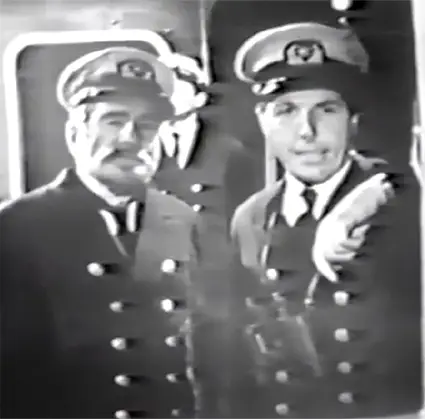
Clarence Derwent as Captain Smith (left) with Lightoller in the
Kraft Television Theatre live TV show "A Night to Remember" (American TV).
"A Night to Remember" is a live “Kraft Television Theatre” American TV production based on the book and broadcast in March 1956 – less than a year after Walter Cronkite’s episode. It was a massive undertaking, with 31 sets and a cast of 107 actors, 72 with speaking parts. 72-year-old stage actor Clarence Derwent filled the Captain’s shoes, albeit ten years Smith’s senior; Derwent died three years later. He appears in the very first shot with Smith shouting to “cast off” as the ship departs. The Captain figures prominently throughout the 50-minute TV show, which the narrator touts is “as accurate as man can reconstruct that night. This is not fiction. This is fact.” In terms of its depiction of Smith, it was certainly the most realistic of its time.
The show’s timeline begins with Smith retrieving the Baltic ice message from Ismay, and the Captain receiving a fourth report during his dinner with the Wideners. The conversation with Second Officer Lightoller at 9 pm is accurately recreated. Interestingly, Smith is shown writing at his desk in his cabin during the collision – the only film to have ever portrayed what he was doing at that moment. He is then informed by First Officer Murdoch on the bridge of what has happened and orders a report “quickly!” He later informs Ismay that the ship is seriously damaged and embarks with Thomas Andrews (who he frequently calls “Tom”) on an inspection of the ship, from which Andrews gives Smith the fatal prognosis. Captain Smith then assigns each officer a duty and instructs the wireless operators to send out a distress call. He is later seen observing the mystery ship on the horizon through a pair of binoculars and orders rockets to be fired to attract attention, and then, on learning the Carpathia is 58 miles away, calculates that they will be “too late.” As the end draws close, a weary-looking Captain releases the wireless operators with “it’s every man for himself.” It is the last we see of the master, seemingly resigned to his fate.
The complex live production was distinctly different from the Hollywood epic only three years prior in its careful documentary approach, with the narrator explaining the exact time, lifeboat numbers and identifying the various individuals concerned in almost every scene.
Laurence Naismith "A Night to Remember"(1958)
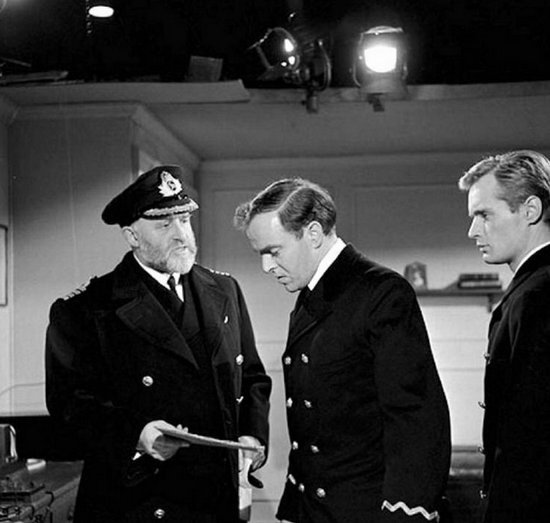
British actor Laurence Naismith (left) is the only actor to receive approval from the Smith family in his portrayal of Captain Smith. Smith's daughter Mel visited the set during its production and was apparantly particularly pleased with Lawrence Naismith’s portrayal
of her father in the film.
British producer William MacQuitty was Belfast born and as a six-year-old saw the Titanic being constructed, launched on 31 May 1911, and sailing away on 2 April 1912, so it was fitting he saw this as his next project. It comes as a surprise that the 1958 film begins with a scene of the hull being christened with much ceremony prior to its launch – a custom that was never adhered to by the White Star Line and surely MacQuitty would have been aware of that as a young observer. It was one of many compromises the Rank Organisation film made to provide a more palatable experience for the audience, the most notable placing Second Officer Lightoller, played by popular actor Kenneth More, in the lead role.
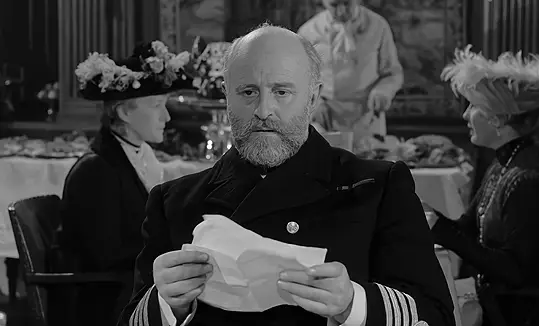
It still retained its documentary approach, with a decision made to film it completely in black and white, in contrast to other Rank films that year such as “Dracula” that were opting for technicolour. MacQuitty’s producer diary reveals that rather than a creative choice, it was mainly due to technical constraints, as the studio did not have access to high-speed colour cameras for the model-effect shots and back projection, as well as the complications of editing in pre-existing library footage all of which was not in colour. His diary also reveals that in September 1957, for purpose of research, the crew watched the 1953 “Titanic,” the German 1943 “Titanic,” the 16mm (kinescope) TV version of “A Night to Remember,” as well as the 1929 “Atlantic.” In another effort to ensure historical accuracy, MacQuitty involved several survivors. Fourth Officer Boxhall, overcoming initial reluctance, came on board as a technical consultant. Second Officer Lightoller’s widow Sylvia also visited the set along with first class passenger Edith Russell, as well as second class passenger Lawrence Beesley who helped advise on the ‘screams’ during the sinking sequences.
50-year-old Laurence Naismith was an obvious choice for the role of Captain Smith. He was a merchant marine seaman before becoming an actor and served nine years in the Royal Artillery, with the final rank of Acting Battery Commander. Even his early films had seafaring themes. He appeared as the steamboat captain in “Mogambo” (1953), a John Ford film with Clark Gable, and then as Dr Hawkins in “Boy on a Dolphin” (1957) that starred Sophia Loren and actor Clifton Webb from the 1953 “Titanic.” Naismith must have felt stereotyped, as immediately after “A Night to Remember” he appeared as the First Sea Lord in “Sink the Bismarck!” (1960), that also starred Kenneth More, as well as Argus in “Jason and the Argonauts” (1963).
Smith appears for the first time in the film on the bridge with Thomas Andrews and Bruce Ismay – (although according to Ismay’s testimony he never visited the bridge until after the iceberg collision). Smith has a throwaway line about possibly arriving early in New York – the insinuation that he was eager for speed, an eagerness that is tempered by Thomas Andrews who warns that rather than a fast trip, it is better to let the engines settle in. Later, in the first class dining saloon, Smith is once again with Ismay (they mostly ate separately). Ismay uses an upright pencil to illustrate that Titanic is as ‘steady as rock.’ Smith laughs heartily when someone knocks the pencil over. What makes this scene more interesting is that it is a rare moment in which we see the Captain without his cap, revealing that Naismith is almost completely bald, and hence a close match for the real Captain’s mostly hairless head (refer to Figure 42). This may well have been another reason why Mel thought Naismith resembled her father so well.
A little later, the jovial gathering is interrupted by “ice warnings from steamers ahead of us” that Smith then passes on to Ismay, as if that was his custom (testimony from Ismay supports him doing this only once – with a later report from the Baltic). The 9 pm conversation between Smith and Lightoller is an accurate recreation, with the captain adding that “if there is the slightest amount of haze, we shall have to slow down.” After the iceberg collision, Smith enters the bridge putting on his great coat and, upon Murdoch’s revelation of what has occurred, walks across to the starboard wing bridge to see if he can see any damage. As reports come in, Smith takes it seriously, telling Andrews when he joins him on the bridge that he thinks she is “badly damaged.”
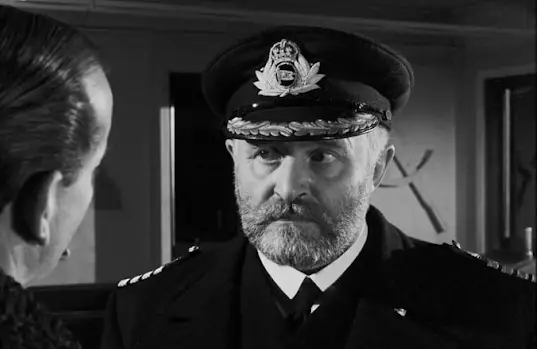
When Andrews explains to Smith by use of the ship’s blueprints that the Titanic will sink, the Captain responds, almost angrily: “But she can’t sink. She’s unsinkable!” On seeing the mathematical certainty she will indeed sink, he comes to a sudden realisation: “There must be no panic. We must be careful what we say to the passengers.” As the enormity of what is about to happen and the lack of lifeboats registers, his last line to Andrews goes unanswered: “I don’t think the Board of Trade regulations visualised this situation. Do you?”
Smith walks out onto the boat deck and looks up in thought, interrupted by the innocent laughs of a young couple. It is a powerful moment. He knows that, in all likelihood, the young couple will be faced with separation within the next hour or so. He walks around the corner into the bridge and addresses the assembled officers and Ismay: “Gentlemen, we are in a precarious position. We must be prepared to abandon ship.” Each officer is given a duty, and an incredulous Ismay is told directly that the ship is going to founder. This is another unfortunate inaccuracy in the film, as Smith never assembled all his officers to inform them of the situation, which led to much confusion over the state of the ship. The wireless operators are hurriedly given the ship’s position by Captain Smith and later, when one brings news of the Carpathia, Smith points out the light on the horizon, a ship “about 10 miles aways” and asks why they have not responded. The Junior wireless operator Bride explains they must not have a 24-hour watch or maybe without wireless at all. The Captain orders distress rockets to be fired. Lightoller follows, reporting the lifeboats are ready and Smith reluctantly orders: “Put the women and children in and lower away.”
After the firing of several rockets, the Captain tells Quartermaster Rowe to try using the Morse lamp. He then instructs Fourth Officer Boxhall to ask Chief Officer Wilde “where the arms and ammunition are kept. They may be needed later.” It is on face value a peculiar request, the reason for which is most likely lost on the casual audience member who would rightly assume he would know where they would be kept. The historical background is that there was some confusion over the whereabouts of the firearms due to the change when Murdoch was “bumped” from Chief to First Officer. Wilde asked Murdoch, who was not sure where the guns were, and Lightloller provided the answer, with Wilde, Murdoch and the Captain consequently following him into the First Officer’s cabin.[i]This scene has been portrayed on screen only once – in the 1958 film. Erroneously, the officers are shown meeting in the Chief Officer’s cabin instead of Murdoch’s, and with some artistic license has Boxhall, Pitman and Lowe also retrieving their weapons, although Lightoller’s account never mentioned the junior officers. Fifth Officer Lowe had his own personal revolver, so it is most unlikely he would have been there.
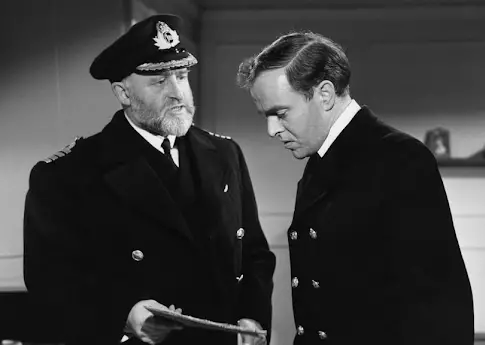
Quartermaster Rowe, after telling the Captain that there has been no response from the mystery ship (“the bastards must be asleep”) is told to help Murdoch, leaving Smith looking at the light on the horizon and saying to himself with some bitterness, “God help you.” Smith asks Phillips, the senior wireless operator, to tell the Carpathia that the engine room is flooding, and they will not be able to transmit messages much longer. Later, he returns to tell Phillips, who is working tirelessly at the wireless telegraph key, that they have done their duty and it is “every one for himself.” Smith leaves while the wireless operators remain.
Captain Smith is standing on the roof of the bridge as he oversees Lightoller with a group of men attempting to lower collapsible lifeboat B from off the top of the Officers’ Quarters. It falls upside down on to the boat deck. Seeing the water flooding the forecastle, Smith lifts a megaphone to his mouth and calls loudly: “Abandon ship! Every man for himself!”
As the musicians play “Nearer my God, to Thee,” Smith climbs back down to the boat deck, sees a woman struggling in the water and then walks into the bridge and stands next to the ship’s wheel. It is the last we see of the Captain. In the following shot we see the bridge go underwater as the bow dips beneath the waves.
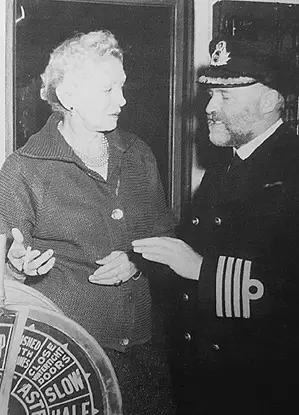
Actor Laurence Naismith talks with the daughter
of the real Captain Smith, Helen Russell-Cooke,
on the set of A Night to Remember, 1958
(Click image to enlarge)
Michael Rennie, "Time Tunnel - Rendezvous with Yesterday" (1966)
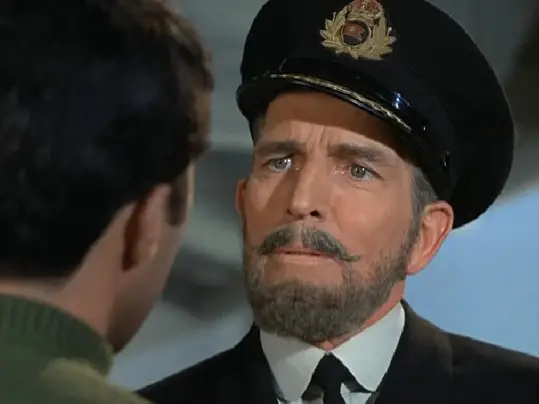
.
On 9 September 1966, a new Irwin Allen, colour science fiction television series, entitled “The Time Tunnel,” debuted on ABC in the United States. For the premiere episode, “Rendezvous with Yesterday,” the Titanic was selected as the location for its storyline about a secret time-travelling project. Historical accuracy was not high on the production agenda, with Michael Rennie playing the role of grey-bearded “Captain Malcolm Smith” (First Officer Murdoch is also incorrectly named “Grainger”) who is portrayed as drinking in first class during the moment of collision with ice. If Mel was infuriated by her father shown smoking a pipe in the 1953 film, she would surely have been inconsolable by this depiction.
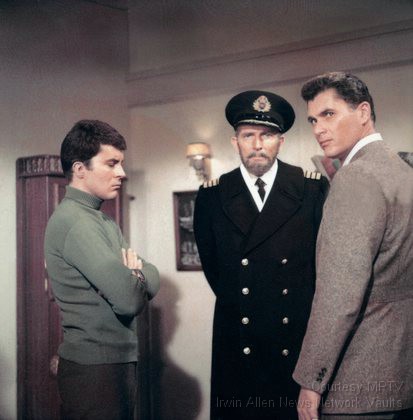
.
Smith tries to thwart the time-travellers’ (Drs Newman and Phillips) attempts to change history, until, after the collision, he realises they were telling the truth after all. This leads to a moment of epiphany and the Captain says with much gravity: “It occurs to me now you might even know whether I will die tonight,” to which Dr Phillips replies: “Yes sir, I’m afraid you will.” Smith pauses a moment and then exits the room without a word.
Harry Andrews, "S.O.S. Titanic - TV Movie" (1979)
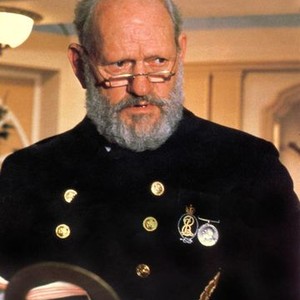
British character actor, Harry Andrews (centre), in the 1979 TV movie.
In 1979 a television movie entitled “S.O.S. Titanic,” was released, a joint British-American production filmed primarily aboard the retired Cunard-White Star ship the Queen Mary moored at Long Beach, California. Smith was played by 68-year-old British character actor Harry Andrews (1911 – 1989, Figure 266), known for squared-jawed, sergeant-major type roles, and his take on the Captain stays largely within those confines. Before embarking on the maiden voyage, he regales his officers with a short speech, telling them that “since there was no formal launching, I should just like to say, ‘God bless this ship and all who sail in her.’” In another moment unique to this film, the Captain is also shown taking his senior officers on a tour of the ship, an accurate and interesting detail not seen in other productions.
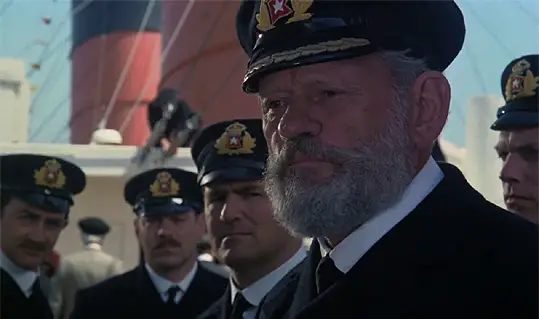
British character actor, Harry Andrews, and the Titanic officers, in the 1979 TV movie "S.O.S. Titanic".
George C. Scott, "Titanic" - TV Miniseries (1996)
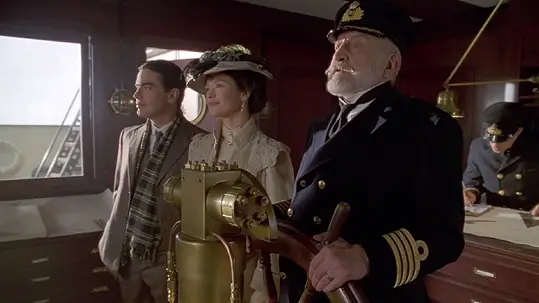
Possibly the most famous actor to play the role - George C. Scott (right) gives an over-the-top theatrical version of the captain.
The 1996 CBS TV mini-series “Titanic” in which George C. Scott – himself a movie legend – is completely miscast in the role, playing it with almost the same theatrics as his previous characters of authority (Figure 267). Scott was almost 70 when he played Smith and it was to be one of his last films, as he died only three years later. Almost every scene he appears in is exaggerated – from reprimanding Ismay for talking to crew about speed prior to speaking with him and reminding him that he is “still the Captain,” to standing behind the ship’s wheel and telling two first class passengers that it is his favourite place as it is “almost sacred,” to then reciting a poem by Tennyson about the sea to Lightoller, it frequently borders on the absurd. There is one touching moment unique to this series: twice Captain Smith refers to a photograph of his wife and daughter, kept in a frame and clearly based on the actual photograph of Eleanor and Mel.
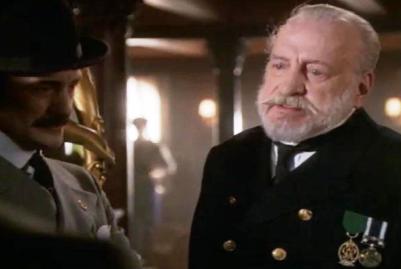
George C. Scott (right) talking with J Bruce Ismay..
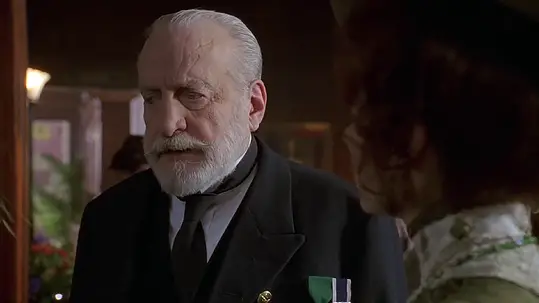
George C. Scott as Captain Smith..
Bernard Hill, "Titanic" (1997)
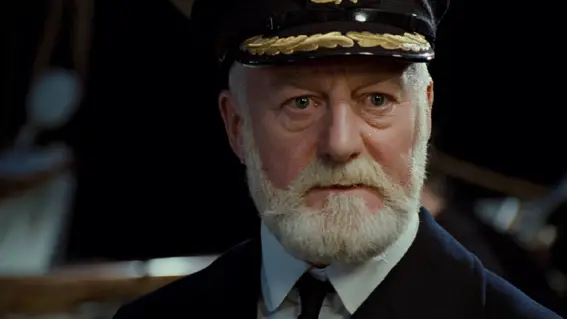
British actor Bernard Hill's performance of the Captain in James Cameron's record breaking and award winning 1997 film renewed the legend to a new generation.
While George C. Scott is likely the most famous actor to play the cinematic Captain, the most iconic will perhaps be Bernard Hill’s performance in the 1997 James Cameron epic “Titanic” that hit theatres in 1997 and, thanks to its record setting appeal (it was the first film to reach the billion dollar mark), is still appearing in cinemas even 25 years later. Cameron originally wanted Robert DeNiro in the role, but the “Godfather” star was unavailable. Manchester born Bernard Hill (Figure 269), who had already appeared in a film about a famous ship’s final voyage (Mel Gibson’s 1984 film “The Bounty”) fortunately channels more of Laurence Naismith’s take on the man than George C. Scott’s, keeping him mostly grounded in historic accuracy. In his first appearance, often referred to as the “Take her to sea, Mr Murdoch” scene, as that is his first line of dialogue, he smiles warmly as he tells the First Officer: “Let’s stretch her legs.” It is also the beginning of a familiar motif throughout the film of the deck officers drinking tea. Fifth Officer Lowe is shown bringing tea to the Captain on the starboard wing bridge and later, during his conversation with Lightoller, Smith is slowly stirring a slice of lemon in his teacup.
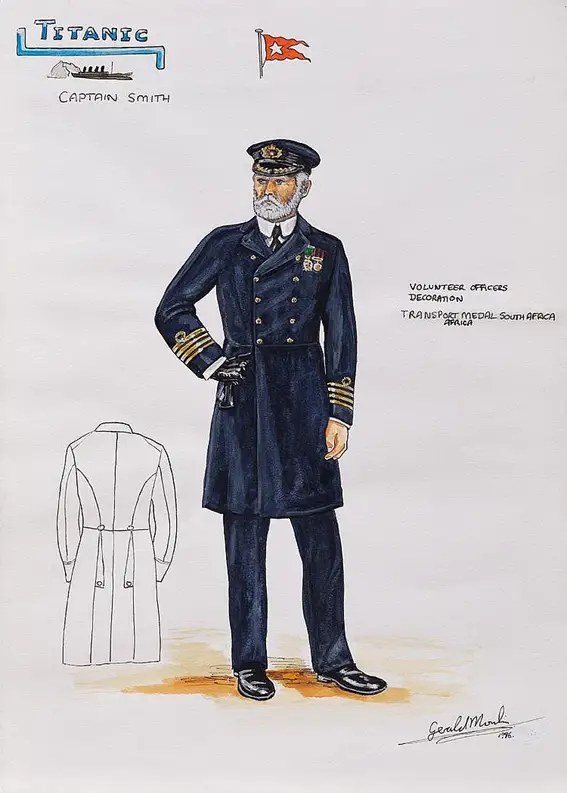
Bernard Hill "Captain Smith" costume sketch that was sold at auction July 29, 2013. From the auction description: "Color sketch of Bernard Hill as 'Captain Smith' from the James Cameron epic Titanic. The sketch is accomplished in pencil and gouache on 10 x 14 in. artist paper. It features 'Captain Smith' in full-dress navy blue uniform holding one of his pair of leather gloves. The sketch features a Titanic title and ship icon in the upper left, a red flag in upper center. “Volunteer Officers Decoration Transport Medal South Africa” in right margin, a detail pencil sketch of the back of the Captain’s coat and signature by the artist, “Gerald Moulin” dated “1996”." (Click image to enlarge)
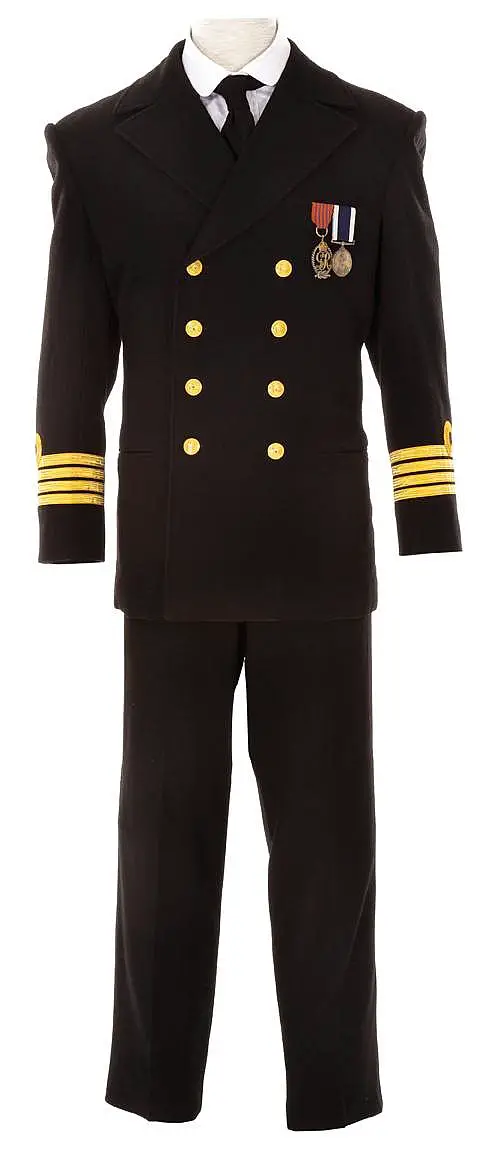
Bernard Hill's costumer from the film.
More disturbingly, Cameron decided to play up the Captain’s allegedly muted response in initiating the lifeboat evacuation, with Lightoller awkwardly coaxing a hesitant order out of him. Smith is also seen in a daze when a third class passenger, cradling a baby, approaches the Captain asking for assistance after most of the lifeboats have gone. This may reference Swedish third class passenger Alma Cornelia Pålsson, who the Captain was reported to have helped with one of her four young children. Cameron chose to have Smith turn away from lending assistance, lost in thought. This has led many to the erroneous belief that the Captain was “inactive” or even comatose as the disaster played out, a cinematic trope that has unfortunately seeped into the historical narrative and a myth that chapter three of this book has hopefully dispelled. To his credit, Cameron does show the Captain attempting to call the lifeboats back (albeit in a deleted scene) and, without a doubt, he stages Smith’s most dramatic cinematic death, with the windows of the wheelhouse imploding as the master grasps hold of the ship’s wheel, to be engulfed by a wall of sea water.
In an interesting twist of fate, through the making of this film and subsequent follow-up documentaries, the director James Cameron made 33 dives to the wreck and calculates that he has spent more time aboard Titanic than even Smith did in 1912.
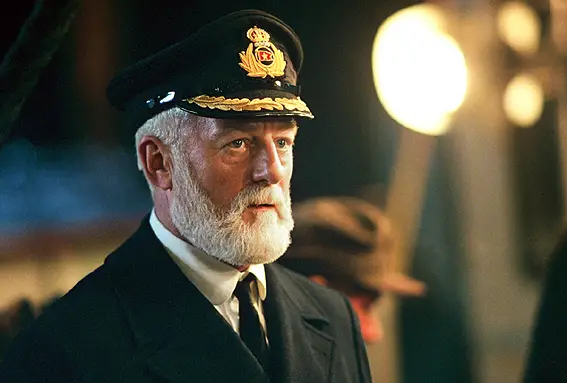
(Click image to enlarge)
Nothing has eclipsed Bernard Hill’s 1997 performance, partly because of his stoic dramatisation and mostly due to the film’s romantic fan base. The role was life-changing. Hill is the only actor to have appeared in two billion-dollar films that have both won 11 Academy Awards – “Titanic” (1997) and “The Lord of the Rings: The Return of the King” (2003). And subsequently, he has appeared in several Titanic documentaries as a presenter and narrator, including the ambitiously titled National Geographic programme “Titanic: Case Closed” (“Titanic’s Final Mystery” in the US) in 2012. The objective was to solve some of the mysteries surrounding the sinking, but only briefly touched on the role of the captain. To its credit, it debunks the myth of Smith travelling too fast or being drunk and describes him as one of the ‘finest captains’ who was doing everything ‘by the book.’ And with its cold-water mirage theory, author Tim Maltin effectively lets Captain Smith off the hook, explaining that the disaster is no longer about ‘incompetent humans,’ rather, it was ‘mother nature’ who was the villain. However, as it was night-time and the highest part of the iceberg would, from the vantage of the lookouts, be below the horizon, it is unlikely a mirage was actually the true culprit on that tragic night.
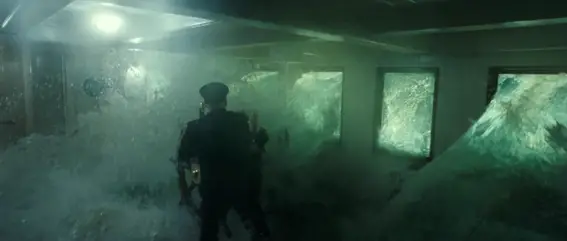
The 1997 "Titanic" version also showed Captain Smith dying in the wheelhouse inside the bridge.
David Calder, "Titanic" - TV series/4 episodes (2012)
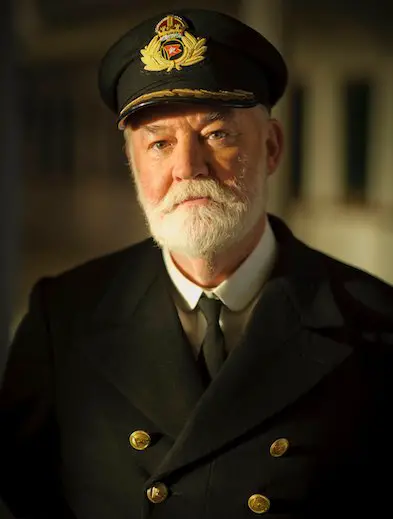
David Calder played the role of Captain Smith in Julian Fellows' (of writer of Downton Abbey) verion of the tragedy.
Julian Fellowes’ 2012 four-part television series had role of Smith played by British actor David Calder. Despite assurances from the creator of the hit historical drama “Downton Abbey” that the programme would set the record straight, its depiction of Captain Smith does quite the opposite – except for showing him with a receding hairline, one of the few accuracies. When Second Officer Blair mentions that his mother will be disappointed by his being “bumped” off the ship, Smith responds sarcastically, “Well, I hope one day she will be able to forgive us.” More disturbingly, Smith is shown pushing for the ship to go faster despite Ismay expressing the opposite opinion (in a bizarre reversal of Ismay film tropes). Smith argues that they can “arrive half-a-day earlier… I think we can make a little headway without frightening the horses.” Just prior to the collision, he says he will “take a tour, then turn in.’ Just before contact with the iceberg, Smith is seen talking with a passenger on the promenade deck. Murdoch clearly puts the blame on the Captain, calling the situation “bloody stupid,” while Lightoller tries to angrily coax an order from Smith to load the lifeboats, as the Captain, so distracted by the mystery ship on the horizon, fails to give the order. These inaccuracies build to his final scene, with Murdoch, where we find Smith cowering between the engine telegraphs. The First Officer tells him that “there is no obligation to go down with the ship, sir,” to which Smith responds: “Isn’t that for me to judge?” Upon learning that Ismay had boarded a lifeboat, Smith prophetically says: “Let Ismay be the coward of Titanic, whereas I’m just the fool who sank her.” Just as Murdoch is about to leave the bridge, Smith adds: “Please don’t think too harshly of me. And tell Mrs Smith my last thoughts were of her.”
Other Portrayals:
Titanic - The Musical
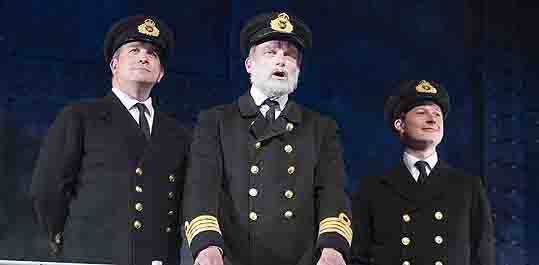
Sion Lloyd, Philip Rham (as Captain Smith) and Dominic Brewer in the Titanic musical at Southwark Playhouse, London in 2013.
Six months before James Cameron’s epic was unleashed, an entirely different kind of portrayal arrived on Broadway on 29 March 1997, in the form of a musical. Despite the unlikely subject for such a genre, “Titanic” was a story written by Peter Stone, based on actual characters, with music and lyrics by Maury Yeston. Broadway thespian John Cunningham, himself a sailor, took the role of the baritone singing Captain Smith, a non-dancing supporting character that is pitched as commanding his final voyage and submitting to an angry Ismay’s demand for speed. In an early scene, the dynamics between Smith and Ismay are established when the chairman brings celebratory champagne onto the bridge to which Smith says, “I’m sorry Mr Ismay – I don’t allow alcohol on my bridge,” to which Ismay responds, “Technically speaking, E.J., it would be considered my bridge.” It is occasionally an endearing role, such as when Smith is seen encouraging First Officer Murdoch “To Be A Captain,” acknowledging the serious responsibility that comes with commanding a vessel with thousands aboard. This is later contrasted with a scene in which Smith, Andrews and Ismay each angrily blame each other for the unfolding disaster, Ismay taunting Smith that he “ignored warnings of icebergs when sighted… and took a course too north for the season…and should have posted more lookouts in darkness.” The scene ends with Smith admitting that “there’s only one Captain, and I was in charge. This is my ship, no one else’s.” He is last seen calling through a megaphone: “I declare this vessel lost. It’s every man for himself!”
The $10 million production featured a large cast and impressive sinking sets complete with falling furniture. Receiving mixed reviews, it won five Tony Awards, including Best Musical, but, after a run of 804 performances, ended with a financial loss. With the possibility of different interpretations, the musical then went on a US tour, a scaled-down ensemble version (reduced to 20 roles) and concert staging, metamorphosing into a variety of international productions, translated into various languages, with baritone actors donning false beards and captain uniforms the world over. Many of these alternate versions went beyond the scope of the original production, such as the Serenbe Playhouse in 2018, an immersive, outdoor venue that built a four-storey ship, with most of the actors falling or sinking into real water.
In 2013, Philip Rham took on the role in the successful London adaptation, directed by Thom Sutherland, that was performed in theatres in the UK and Ireland in the years 2015, 2016 and 2018 and then internationally in 2019, and in China in 2023. During the 2023 UK, Ireland and Taiwan tour, the role was taken over by Graham Bickley, an English actor and singer best known for the 1980s television sitcom “Bread.” Celebrating its tenth anniversary on tour, the British version of the musical is also being released in 700 cinemas across the US in November 2023, along with UK cinema, TV, streaming, and DVD releases the following year.
Titanic VR (2018)
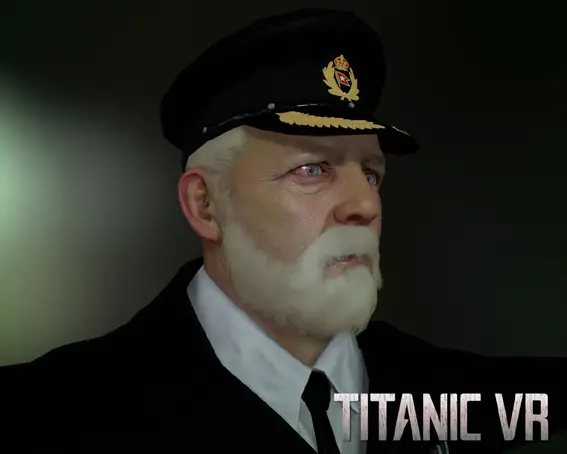
An Ireland based company, Immersive VR Education created an 360/VR educational interactive story and game including the sinking and wreck, and a recreation of Captain Smith.

The VR/360 recreation of Captain Smith even went so far as to get a look alike
for Captain Smith to be captured digitally.
Titanic: Honor & Glory (In Development)
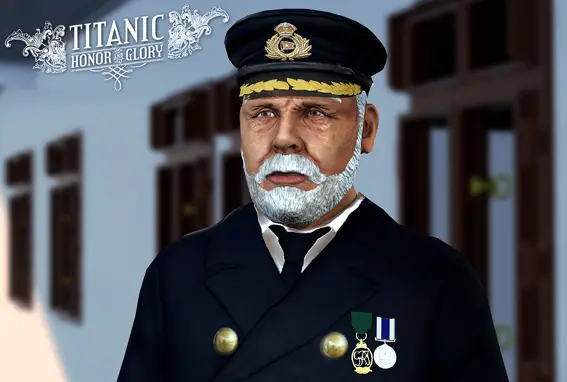
"Honor & Glory" is a video game currently under development by Vintage Digital Revival (Four Funnels Entertainment) that will feature the most accurate digital representation of the RMS Titanic to date, and originally intended to have historical characters including Captain Smith as part of the game, although this concept looks like it has been dropped from the game.
